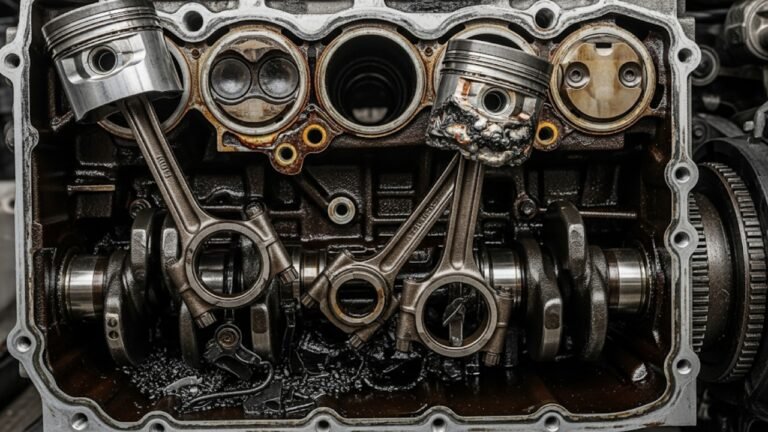How to Know If Your Car Oil Is Low: A Friendly Guide

Think of engine oil like blood in your veins. It flows, it protects, and it keeps everything alive. When your car oil is low, you’re not just dealing with an inconvenience—you could be putting your engine at risk. But here’s the thing: most people don’t realize it until it’s too late.
I remember driving through the hills of Sylhet on a summer day. The engine light blinked, and I ignored it. A week later, my engine overheated, and the mechanic’s words hit me hard: “Your engine oil was too low.” Since then, I’ve learned the hard way—and now I want to help you avoid the same mistake.
So if you’re wondering how to know if your car oil is low, stick with me. This guide is for anyone who wants to keep their car running smoothly, without getting too technical. We’ll talk symptoms, checks, tips, and some personal truths.
What Does Engine Oil Actually Do?

Here’s what it does:
Lubricates all the moving parts to reduce friction.
Cools down your engine by carrying away heat.
Cleans the engine by picking up dirt and debris.
Seals small gaps between engine parts.
Prevents rust and wear.
Without enough oil, your car’s engine is running dry, heating up, and breaking down over time.
Think of it like running a marathon in the sun—without any water. That’s what your engine goes through without enough oil. So knowing how to know if your car oil is low is not just car care; it’s survival for your vehicle.
Common Signs Your Car Oil Is Low
You don’t always need a mechanic to tell you something’s wrong. Your car is smarter than you think—it talks to you, just not with words. Here are some everyday signs that your engine oil might be running low:
Engine Overheating: Oil cools your engine. If it’s low, temperatures rise.
Oil Pressure Warning Light: If this pops up, don’t ignore it.
Strange Engine Noises: Knocking, ticking, or grinding means parts are rubbing dry.
Exhaust Smoke: Blue or dark smoke may mean oil is burning.
Poor Fuel Economy: Less lubrication = more energy needed = more fuel used.
Each of these is like your car whispering: “Help me.” Don’t wait until it’s shouting.
How to Manually Check Your Car’s Oil Level
Let me tell you something I learned from my father, who loved his 1996 Toyota Corolla more than sweets. He used to say, “The dipstick never lies.”
Here’s how you do it:
Park on a level surface and turn the engine off.
Wait 5-10 minutes so oil settles.
Open the hood and find the dipstick (usually with a yellow or orange ring).
Pull it out, wipe it clean, reinsert it fully, then pull it out again.
Check the oil level mark. If it’s below the lower line, your oil is low.
Look at the color and texture. Clean oil is amber and smooth. Dirty oil is dark and thick.
What Dipstick Results Mean
| Oil Level | Color | Action |
|---|---|---|
| Full | Amber/Light Brown | All good, no need to add. |
| Low (below line) | Brown/Black | Add recommended oil ASAP. |
| Milky/Cloudy | White-ish | Possible coolant leak – see mechanic. |
| Gritty or Sludgy | Black with bits | Time for an oil change. |
Checking your oil only takes five minutes—but it can save you from a 50,000-taka engine repair. Seriously.
How Often Should You Check Your Oil?
If you’re like me, you probably check your phone 100 times a day. But when was the last time you checked your engine oil?
Here’s a simple rule:
Check your oil once every 2 weeks or before any long trip.
And remember:
For older cars (10+ years), check more often.
If your car burns oil, increase the frequency.
Always check after an oil change to ensure it was done right.
Checking regularly is like checking your bank account—you don’t want surprises when it’s empty.
Low Oil vs. Dirty Oil – What’s the Difference?
Now here’s a little confusion I see often: people mix up low oil with dirty oil. They’re not the same thing.
Low oil means there isn’t enough.
Dirty oil means the oil is there but not doing its job well.
You can have full oil that’s old and useless. Or you can have fresh oil but not enough of it. Either way, your engine suffers.
I once changed my oil just before a trip to Cox’s Bazar. Didn’t realize the guy only filled half the needed amount. My engine was quiet but struggling—until I topped it up myself.
So check both the level and the quality of the oil every time. Your engine will thank you.
Why Does Engine Oil Run Low in the First Place?
You might wonder—why does engine oil get low? Is your car leaking? Is it burning oil?
Here are some common reasons:
Oil leaks from seals or gaskets.
Oil burns inside the engine due to worn-out parts.
Oil evaporates slowly in older engines.
Overdue oil change—old oil breaks down faster.
Damaged oil pan from hitting potholes or bumps.
If you see oil stains on your garage floor or your car smells like burnt oil, don’t ignore it. Get it checked. Quick.
What Happens If You Drive With Low Oil?
I hate to scare you, but here’s the truth—driving with low oil can destroy your engine.
Imagine this: two metal gears grinding without anything between them. That’s your engine on low oil.
Here’s what could go wrong:
Engine parts overheat and wear out.
The engine seizes and stops working.
You’ll need a full engine rebuild—costing thousands.
I once helped a friend tow his Honda Civic after he ignored the low oil light. The engine locked up on the highway. The fix? A brand-new engine.
Don’t be that guy.
What to Do If Your Oil Is Low
So you’ve checked and found your car oil is low. What now?
Here’s what to do:
Top up with the right oil type (check owner’s manual).
Don’t overfill. Stop once it hits the top line on the dipstick.
Check for leaks under the car or around the engine.
Schedule an oil change if the oil looks dirty.
Visit a mechanic if the oil drops again soon.
It’s simple, really. Low oil is not the end of the world—if you catch it in time.
Types of Engine Oil and How They Affect Oil Levels
Choosing the right engine oil is just as important as having enough of it. The wrong oil can cause it to burn faster, leak more easily, or fail to lubricate properly.
Here’s a quick breakdown:
Main Types of Engine Oil:
| Type | Best For | Effect on Oil Consumption |
|---|---|---|
| Conventional | Older vehicles, basic use | Burns quicker, needs frequent checks |
| Synthetic Blend | Daily driving, better protection | Balanced performance and cost |
| Full Synthetic | High-performance, modern engines | Lasts longer, better under heat |
| High-Mileage | Cars with over 75,000 miles/km | Reduces leaks, burns slower |
When you know how to know if your car oil is low, you should also know which oil to use to avoid that issue in the first place. Always check your car manual or ask a trusted mechanic. I personally use full synthetic for my newer sedan—it stays stable longer, especially in the Dhaka heat.
How to Prevent Your Car Oil from Getting Too Low
Here’s the good news: you don’t have to wait until your oil is low. You can prevent it with a few simple habits.
Helpful Habits:
Stick to your oil change schedule: Don’t delay it.
Check your oil regularly: Make it part of your weekly routine.
Fix leaks immediately: Even a small drip adds up over time.
Avoid rough driving: Hard acceleration increases oil usage.
Use quality oil and filters: Cheap parts cost you more in the long run.
Imagine treating your engine like a friend. You wouldn’t let your friend run a marathon dehydrated, would you? Same with oil—keep it topped up, clean, and flowing.
Common Myths About Engine Oil Levels
There’s a lot of bad advice out there. Let’s bust a few myths.
Myth 1: You only need to check oil at oil change time.
Truth: Oil can drop in between. Always check every few weeks.
Myth 2: Thicker oil means better protection.
Truth: Not always. Use the viscosity your manufacturer recommends.
Myth 3: The oil light means you need an oil change.
Truth: It usually means low oil pressure—which is way more urgent.
Myth 4: New cars don’t need oil checks.
Truth: Even new engines can burn oil. Check regularly.
It’s easy to fall into these traps. Trust real experience and your owner’s manual—not uncle YouTube’s advice.
Final Checklist: Is Your Car Oil Okay?
Use this quick checklist every few weeks:
Car parked level and cool?
Pulled and cleaned the dipstick?
Oil level between the marks?
Color is amber/light brown?
No burnt smell or metal bits?
No fresh leaks under the car?
If you answered yes to all, you’re golden. If not, it’s time to act.
FAQs on How to Know If Your Car Oil Is Low
Q1: What happens if I accidentally overfill the oil?
A: Overfilling causes foaming, poor lubrication, and pressure issues. Drain the excess immediately.
Q2: Can I drive with low oil just for a short distance?
A: Not a good idea. Even short drives can cause damage. Add oil first.
Q3: Is it okay to mix different oil brands?
A: Yes, in emergencies. But try to stick to the same viscosity and type.
Q4: My oil looks black. Should I change it?
A: Dark oil isn’t always bad—but if it’s thick or gritty, change it.
Q5: Why is my car still losing oil after a recent change?
A: You may have a leak or your engine is burning oil. Check for signs or consult a mechanic.
Closing Thoughts: Love Your Car, and It’ll Love You Back
Your car isn’t just a machine. It’s your daily partner, your travel buddy, your quiet space on long drives. And like any partner, it needs care.
Learning how to know if your car oil is low is a basic skill that goes a long way. You don’t need fancy tools—just a rag, a few minutes, and a little love for your vehicle.
I hope this guide didn’t just teach you something useful but gave you the confidence to take better care of your car. It’s not about being a mechanic—it’s about being a responsible driver. And honestly, that’s something we all can be.






